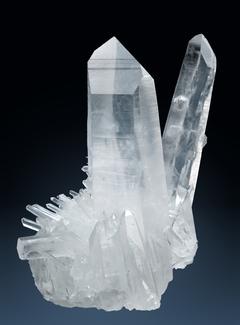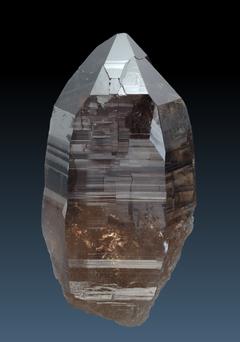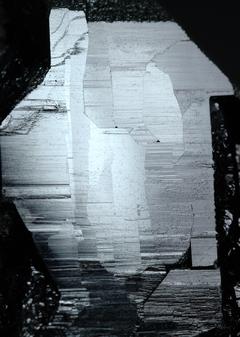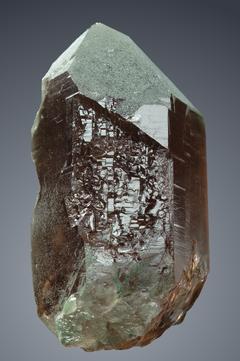last modified: Sunday, 19-Nov-2023 14:34:28 CET
Document status: new, construction site
This chapter deals with the macroscopic structure of quartz crystals. If you are looking for a description of quartz molecular structure, check out the chapter Quartz Structure.
Two Types of Quartz Crystal Structure
Crystals grow by adding layers of their basic building blocks (atoms, ions, molecules) at their surface. From this one would expect all crystals to be completely homogeneous.However, in response to lattice defects, quartz crystals may develop two types of internal structural compartimentation:
- Lamellar Structure, the crystals are sometimes called "Bambauer Quartz"
(Bambauer et al. 1961)
- Macromosaic Structure, the crystals are sometimes called "Friedlaender Quartz"
(Friedlaender, 1951)
Apparently there are no intermediate forms, and both structures are mutually exclusive. Certain specimens show both structural types in one crystal, but the respective parts of the crystals grew at different developmental stages.
It must be stressed that there are crystals that are neither lamellar nor macromosaic.
Lamellar Structure
These crystals contain single or multiple thin sheets ("lamellae") that deviate in their chemical and optical properties and that are oriented parallel to the crystal faces. The sheets may merge and give the crystals an onion-like layered structure, in particular in the outer parts, but more commonly the crystals contain only isolated areas of multiple sheets parallel to the prism faces, and close to the surface. The structure was first described by R. Weil in 1930 in crystals from a number of locations (La Gardette in the French Alps, Ouachita Mountains in Arkansas, Binntal in Switzerland, and localities in madagascar and Brazil). The fine layers parallel to the prism and rhombohedral faces were found to be optically biaxial (see Optical Mineralogy at Brock University for an explanation), which is an astounding deviation from the normal uniaxial optical behavior of quartz crystals. Weil also found that the layers are more easily etched by hydrofluoric acid. The optical behaviour can only be observed with a polarizing microspoce in thin sections of crystal. The optical properties and the relation of these phenomena to the trace element distribution in the crystals have been studied in detail in crystals from Madagascar by Bambauer et al. in 1961. The biaxial lamellae in these crystals were associated with increased levels of aluminum, hydrogen and lithium. Upon irradiating the crystals the lamellae assumed a smoky color, resulting in multiple smoky phantoms or color "zoning". Etching the crystal slices did not reveal Dauphiné law twinning. The polysynthetical Brazil law twins commonly found in amethyst show a similar onion-like structure, but Brazil law twinning could not be detected. The layers found in quartz with a lamellar structure are apparently not associated with and not related to any type of twinning. In fact, in another study (Niedermayr, 1993) lamellae have been found to cut through irregular Dauphiné twin domains.In the specimens from Madagascar studied by Bambauer et al., 1961, the lamellar structure was found in the outer parts of the crystals under the positive and negative rhombohedra at the tips, but only under the prism faces situated under the negative rhombohedra. In a study on the trace element content and internal structure of quartz crystals from the central Swiss Alps, Bambauer (1961) describes crystals with lamellae concentrated in the outer parts of the crystals. Hertweck et al., 1998 also found lamellae predominantly in external parts of quartz crystals from alpine-type fissures in Austria.
The term "lamellar quartz" is also frequently used for quartz crystals and grains that have developed secondary lamellae that run through the crystal in response to mechanical deformation. This lamellar structure is not related to that discovered by Weil. It has frequently been observed in quartz grains near impact craters, and thus lamellar structures in quartz grains serve as a diagnostic feature in geosciences, commonly interpreted as a record of an meterotic impact event ("shock-induced lamellar structure"). Lamellar structures may also develop in quartz crystal grains during shearing of the host rock.
According to Rykart, 1995, crystals that grew relatively fast tend to develop as lamellar quartz, for example, needle and skeleton growth forms. Many scepters also seem to have a lamellar structure, in particular those that show skeleton growth forms. The habit of crystals can be an indication of lamellar internal structure, too, like a pronounced trigonal habit or a Dauphiné habit.
Even though it assumes typical growth forms (needle, skeleton quartz), it is not possible to recognize a quartz crystal with lamellar structure from its outer shape or morphology.

10mm 1088x1472 134kb - 2176x2944 392kb |
Macromosaic Structure
Crystals with a macromosaic structure appear to be made of many irregular crystal domains or crystallites, crystal "subindividuals", within the crystal that are slightly displaced and tilted with respect to each other.
In contrast with lamellar quartz, macromosaic quartz is easy to recognize. The borders between the crystal domains are visible as fine cracks or lines called sutures. People often think these lines are twin boundaries, but they are not and they cannot be, as discussed in the crystal twinning section.
Crystals with a macromosaic structure are often found in alpine-type fissure environments, but also in pegmatite and miarole pockets. A beautiful example from a miarole pocket is shown in the chapter Occurrence. Macromosaic quartz may show a normal habit or transitional or Tessin habits. One growth form always has a macromosaic structure: the gwindel.
Because of the occurrence in certain environments and the association with certain growth forms, it is likely that macromosaic quartz grew at relatively high temperatures.
Macromosaic quartz from alpine-type fissures certainly grew very slowly, but since crystal growth speeds in pegmatite environments are still a matter of debate, it is not certain that slow growth is a requirement for macromosaic formation.
This smoky quartz crystal has once been intersected at one of its prism faces by another crystal whose c-axis was tilted to the left by about 50°. The other crystal came off and left an imprint on the prism face with a straight edge at its top. Although I did only find this single crystal and not the intact group of this crystals with its former counterpart, it is unlikely that this pattern has developed because of a healing fracture surface: Green chlorite covers all crystals faces, most of it on the rhombohedral faces at the tips, and a much smaller amount on the prism faces. The chlorite was incorporated at the final stage of crystal growth. So had any growth happened on the fracture surface, at least some chlorite should be found on it, but the imprint is completely free of it. The specimen is from Val Giuv, Tujetsch, Graubünden, Switzerland.
In his "Quarz-Monographie" (Rykart, 1995) Rykart classifies many growth forms and habits as characteristic of and caused by either lamellar or macromosaic internal structures (unfortunately, he does not substantiate his classification with literature references or the presentation of raw data from his own studies, e.g. thin sections of crystals and measurements of biaxial zones). Although Rykart does not state this explicitly, this can be (and often is) interpreted as if there were only two different types of quartzes and a crystal is to be either of lamellar or macromosaic internal structure.
However, both lamellar and macromosaic structures are responses of the crystal to disturbances during growth and the resulting lattice defects. An ideally developed crystal will not show these internal structures. As far as I know, there is no comprehensive investigation of possible correlations between the external shape and the internal structure for quartzes found in a wide variety of geological environments. Niedermayr has studied these correlations in quartz crystals from alpine-type fissures in Austria (Niedermayr, 1993). He found that crystals without external sutures are not necessarily crystals with lamellar structure, although the likelihood for polysynthetical Brazil law twinning in these crystals is higher. Polysynthetical twinning is easily confused with the presence of biaxial lamellae, and a visual inspection with the naked eye is insufficient to identify lamellar quartz. Also note that Hertweck et al., 1998 found lamellae mostly in external parts of crystals, often with cores free of lamellae.
Copyright © 2005-2022, A.C. A k h a v a n
Impressum
- Source: http://www.quartzpage.de/crs_struct.html
This smoky quartz with a "Binntal habit" nicely demonstrates the typical look of a macromosaic crystal. The frontal prism and the shiny rhombohedral face appear to be shattered. Parts of the sutures run parallel to the edges of crystal faces, most obviously on the shiny rhombohedral face. Another common feature is that the striation on the m prism faces are not continuous and the striation patterns of crystal domains do not match each other. The crystal is from the eastern Binntal, Wallis, Switzerland and also presented in the crystal habits section.

10mm
![]()
1000x1424 130kb -
2000x2848 427kb
Light reflections on a prism face of a smoky quartz crystal from Val Giuv, Graubünden, Switzerland. Careful illumination reveals the typical surface pattern of a macromosaic crystal. The surface looks like a mosaic of more or less irregular lengthy patches, a bit like a broken tile. The crystal is perfectly clear and all patches have the same color and are equally reflective, but because the mosaic elements are slightly tilted in varying directions, their surfaces are not parallel to each other. So when one illuminates the prism face with a diffuse and gradational light source, the various patches light up in different brightnesses.

5mm
![]()
992x1392 260kb -
1984x2784 716kb
If a macromosaic crystal breaks, its fracture surface is conchoidal and looks like broken glass, or like the fracture surface of any other quartz crystal. But if a crystal has been partially intergrown with another quartz crystal and the crystals get separated, one can sometimes see the typical macromosaic structure as a surface pattern with a strong relief that reflects the three-dimensional structure of the crystal domains.

10mm
![]()
1000x1504 286kb -
2000x3008 839kb
Is there only "Lamellar" and "Macromosaic" Quartz?
No.
 Printer Friendly Version
Printer Friendly Version
